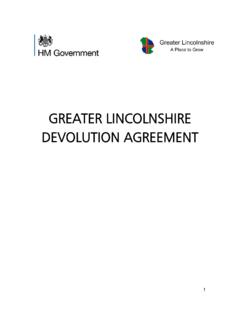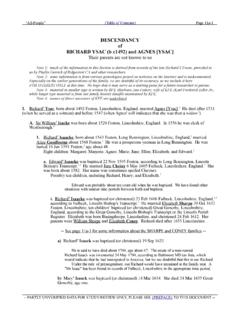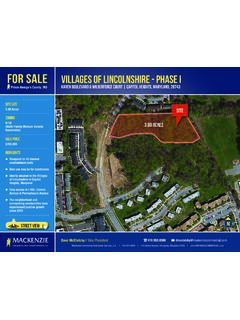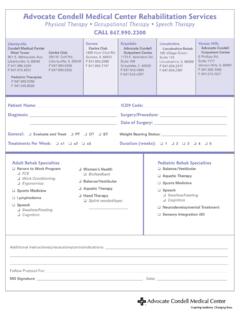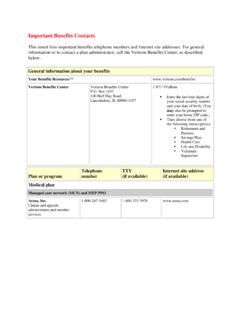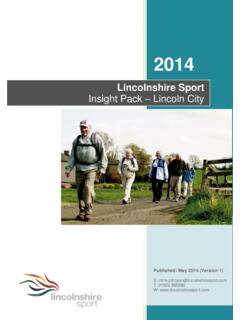Transcription of The Value of Food and Farming in Lincolnshire
1 1 The Value of food and Farming in Lincolnshire Introduction In recent times the spotlight has been shining increasingly on the importance of Agriculture and the food Industry to the British economy and on its economic contribution in addition to its other roles. The National Farmers Union has responded to this pressure by launching a Why Farming Matters campaign, which aims to reassess the importance of British agriculture and horticulture in the context and circumstances of the 21st century. This report investigates the Value and importance of Lincolnshire s agricultural and food production activities, both nationally and to the local economy, how this has changed over recent years and challenges for the sector in the future.
2 The agricultural and food industries are referred to together in this report under the banner of food and Farming . This is because in many cases the two sectors are intrinsically linked so that it is almost impossible to define the Value and importance of one sector alone, the two being highly dependant upon each other in Lincolnshire . Figure 1. The food Chain Improving access to quality information through partnership working UK consumers Exports Consumers expenditure on catering services Total consumers expenditure on food and catering services Household expenditure on food and drink Catering Grocery retailers food and drink wholesalers food and drink manufacturing Distribution in all parts of the chain food & drink supply industry Agricultural wholesalers Farmers and primary producersImports Agricultural supply industry 2 In all cases the information used is the latest available however, due to time lags in the release of Government data, especially in Gross Value Added (GVA)
3 , nationally available data has been augmented with data from a leading forecast company, namely Cambridge Econometrics. Use of the Local Economy Forecasting Model (LEFM) developed by Cambridge Econometrics has also allowed us to provide a vision of how industry sectors within the Lincolnshire economy might change in the future. Importance to local area British farmers and growers produce 60% of the UK s total food supplies and nearly 75% of all foods consumed in the UK that can be grown in our climate. In 1996 we produced more of our own food than at any other time since the mid-nineteenth century, however, that level of self-sufficiency has been falling due to lower UK production, reduced exports and increased imports1.
4 There are mixed reasons for these changes including the sourcing strategies of large retail companies and consumer demand for round the year availability of seasonal produce has led to increased imports, which then compete with local produce in-season. A recent report by the NFU found that since 1998, food prices have risen by just compared to an increase of 22% in retail prices generally, and prices to farmers have actually fallen over the same period, by 9%. Agriculture and horticulture contribute more than 5 billion Gross Value Added (GVA) to the UK economy each year and employ more than half a million people, mostly in rural areas. In Lincolnshire more than 1 in 10 people are currently employed in food and Farming , and together they contribute nearly 13% of the county s GVA, which equates to more than 1 billion each year2.
5 The county s food and faming sector is not just of importance to the people of Lincolnshire , nearly a quarter of all land used for horticulture in England is in Lincolnshire and for peas, beans, vegetables and salads the proportion is higher. For a very long period of time, Farming has provided a relatively stable contribution to the local economy which in turn has led to the establishing of many related industries such as food processing and distribution activities with the result that food and Farming provide a substantial amount of financial Value and employment to the county as illustrated in figure 2. The table shows Gross Value Added (GVA) for a range of industrial sectors in Lincolnshire and how these have changed over time from 1981 to the present, and how they are projected to change in the future, a projection based on recent trends.
6 The table is shown in descending order of industry GVA in 2006 and is rounded to nearest 10m. 1 Defra, Agriculture in the United Kingdom 2006. 2 Cambridge Econometrics, Local Economy Forecasting Model (LEFM) 2006. 3 Figure 2 Gross Value Added ( m) 1 Sector 1981 2006 2020 Government & Other Services 1,160 2,050 3,000 Distribution, Hotels & catering 750 1,920 2,540 food and Farming 620 1,050 1,010 Non- food Manufacturing 670 930 1,100 Financial & business Services 410 860 1,270 Construction 280 790 990 Transport & communications 240 530 820 Mining & Energy 100 110 140 Lincolnshire Total 3,910 8,140 10.
7 700 Figures are shown rounded to the nearest 10m. Some slight changes are projected in the position of certain sectors over the period to 2020, with Financial and Business Services projected to move above Manufacturing and food and Farming by 2020 in terms of GVA. The proportion that each industry sector s GVA makes up of the total for the county is shown alongside figures for the UK in Figure 3. The table is shown in descending order of the sectors relative Value within the Lincolnshire economy. Figure 3 Gross Value Added (%) Sector Lincs UK UK = 100 Government & Other Services 25% 24% 104 Distribution.
8 Hotels & catering 24% 17% 141 food and Farming 13% 3% 433 Non- food Manufacturing 11% 13% 88 Financial & business Services 11% 26% 42 Construction 10% 6% 166 Transport & communications 7% 9% 78 Mining & Energy 1% 1% 0 As can be seen from the table, the contribution food and Farming make to the county s economy is more than 4 times that of its contribution in the national economy highlighting the higher dependency the county has on this industry. Information from the Local Economy Forecasting Model (LEFM) has also been used to illustrate employment within major sectors of the Lincolnshire economy.
9 These estimates are shown in figure 4 and include both employees and the self-employed. The table is shown in descending order of industry employment in 2006, and shows the sectors of Government and Other Services and Distribution, Hotels and Catering to be the largest employers in 1981 and 2006, as well as in projected employment figures for 2020. The food and Farming sector, made up of agriculture and food and beverage production activities was estimated to employ more people than the Construction, Financial and Business Services and Non- food Manufacture sectors in 2006. 1 Figures are from the LEFM and for 2006 / 2020 are estimates / projections.
10 Sector figures do not sum to the Lincolnshire total as estimates for unallocated GVA are not included. 4 Figure 4 Employment (000 s)1 Sector 1981 2006 2020 Government & Other Services 54 93 112 Distribution, Hotels & catering 56 77 90 food and Farming 50 32 21 Construction 14 30 29 Financial & business Services 19 29 32 Non- food Manufacturing 40 27 25 Transport & communications 11 15 16 Mining & Energy 2 1 1 Lincolnshire Total 246 304 324 Figures are shown rounded to the nearest 1,000.


